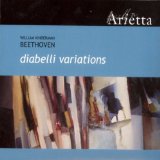Recordings

Beethoven: Diabelli Variations
(2-CD set includes complete studio recording and 45-minute lecture recital)
Buy through Amazon or Parasol Records [streaming options found here]
“The most outstanding Diabelli Variations to have appeared for ages”

Beethoven: The Last Three Piano Sonatas
Buy through Amazon or Parasol Records
“The final cycle of Piano Sonatas which Beethoven composed could be said to contain his innermost thoughts and intrinsic brooding on mortality. No other composer ever breached such uniquely forbidding walls of pianistic mastery and even today Op. 109-111 are lofty ivory towers in any pianist’s canon.
William Kinderman is suitably equipped to rise to such a challenge especially in the wonderful Op. 109, which is imbued with pianistic virtuosity and deep sense of feeling. Conversely he is as savage and brutal as one could expect in the First Movement of Op. 111; a true exposition of artistic ferocity.
The disc is supplied with excellent notes written by Kinderman himself and is also superbly recorded. This is an ideal introduction to some of the greatest works ever written for the piano.”
Composition
Bee[t]h[ov]e[n] for solo piano (2015)
Celebrated and long familiar is the sounding symbol for Bach—the four tones B flat, A, C, B natural—which in German musical terminology spell out the four letters of the composer’s name. Unfamiliar is the corresponding symbol for Beethoven. From the five sounding letters B–E–E–H–E—whereby B is expressed as B flat and H as B natural—we hear at once a pregnant motive that conveys the mysterious quality of the piece. The notation of this motive, with the inclusion of apparently superfluous natural signs before the notes on E, convey an obsessive atmosphere. Where are we led by this musical idea? An ominous, descending countermelody is soon combined with the Beethoven motive before we hear a fleeting lyrical passage, a utopian glimpse before the fateful idée fixe resumes. Thereafter the falling countermelody returns and breaks through with tragic force: springing from rapid scale passages, glissandi sweep across the entire keyboard, while the main motive thunders in chords in the deepest register of the bass. Yet at the conclusion the original motive returns. What lurks behind this deceptively simple utterance, which stands as an emblem for the composer?
Berühmt seit eh’ und je ist das klingende Symbol für Bach—die vier Töne B, A, C, H—während die entsprechende Tonsymbolik bei Beethovens Namen unbekannt geblieben ist. Aus den fünf klingenden Buchstaben B–E–E–H–E entsteht ein prägnantes Motiv, das die mysteriöse Grundstimmung des Stückes lenkt. Die Notation dieses Motivs, mit den anscheinend überflüssigen Auflösungszeichen vor den Noten auf E, vermitteln eine Stimmung der Besessenheit. Wohin werden wir geführt? Eine ominöse, absteigende Gegenstimme wird mit dem Beethoven-Motiv kombiniert, dann hören wir eine flüchtige lyrische Stelle, ein utopischer Blick bevor das schicksalshafte Hauptmotiv wiederkehrt. Nun kehrt die absteigende Gegenstimme wieder vor und bricht mit tragischer Kraft durch; aus rapiden Tonleiter entstehen Glissandi über die ganze Klavieratur, während das Hauptmotiv in tiefen Akkorden donnert. Doch zum Schluss ertönt nochmal das ursprüngliche Motiv. Was verbirgt sich hinter dieser anscheinend so einfachen Aussage, die emblematisch für den Bonner Tonmeister steht?
